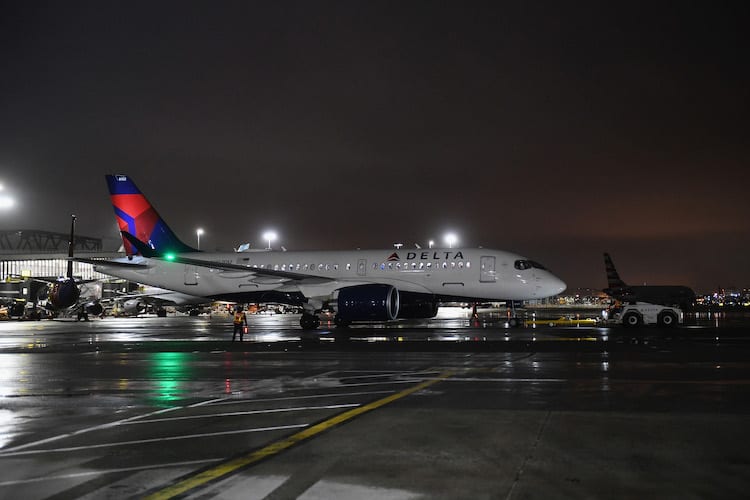
Delta Air Lines Celebrates the launch of the first Airbus A220-100 aircraft at LaGuardia Airport on February 7, 2019 in New York City.
On Thursday, Feb. 7, 2019, Delta Air Lines completed the first passenger-carrying flight of its new Airbus A220, the first U.S. carrier to do so with the new jet following Airbus’ recent regulatory approvals for extended operational flight times and auto-landing features.
The journey to Delta becoming the North American launch operator of the A220 was extended by the recent partial government shutdown, which delayed its entry into passenger-carrying service four years after it started flying as Bombardier’s C Series. Their first commercial flight was the A220-100 variant featuring 109 seats, LED ambient lighting and Gogo’s 2Ku in-flight connectivity antennas, modem and wireless access points.
Re-branded as the A220 in 2018, the aircraft is a rare bird within the 100-150 seat passenger jet market because of the way it can extend traditional intercontinental flying to trans-Atlantic trips between Heathrow and La Guardia.
Transport Canada’s 180-minute ETOPS approval for the A220 is the first it has ever issued for a commercial airliner. Rob Dewar, head of engineering for the Airbus A220 program, told Avionics International that one of the flight control features his team really focused on improving for A220 pilots is when landing the aircraft.
“The avionics fly-by-wire software was designed to provide a dedicated heads up display guidance and aural cues to the flight crew to ease handling of the landing. For instance, a dedicated flight control law has been developed to automatically extend the flight spoilers and provide more capability for the landing maneuver,” Dewar said.

Delta’s Airbus A220 cockpit. Photo: Delta Air Lines
The first major avionics system upgrade was recently introduced on the A220 in the form of a CATIII autoland certification added to the aircraft’s European type certification in November.
“The avionics’ autopilot algorithm was slightly updated during the development of the autoland system, enabling CATIII operations capabilities. This was therefore part of the service bulletin released for CATIII,” Dewar said.
“Regular avionics service bulletins are released to keep improving the systems abilities, this is performed as part of industry standard continuous product improvement,” he added.
Delta’s new A220 also features a suite of new pilot tablet integration functionality into the aircraft’s avionics data bus. One of the factory options available on the aircraft is Esterline CMC’s aircraft information server, an integrated information management system and network connectivity.
Additionally, since the new A220 features Gogo’s 2ku connectivity, Delta can extend the connected cockpit turbulence monitoring application its pilots are already using on other aircraft types. All of Delta’s pilots currently use the carrier’s own internally developed flight weather viewer tablet application, which gives pilots a three-dimensional color-coded view of their flight path and a depiction of turbulence along that path. They also have the option of adding a visual representation of flight environment items such as cloud top heights or volcanic ash.

Delta pilots learn how to use the Airbus A220’s cockpit avionics. Photo: Delta Air Lines
An overview of pilot usage of the app has shown that Delta pilots have reduced the number of times they change altitude in search of smooth air from up to seven times to two or three times over the course of an average two-hour flight.
Airbus has also positioned its new A220 as capable of flying where no other aircraft in its class can fly to.
“The A220 is the only in-production aircraft in its class capable of both serving most challenging airports, such as London City airport, because it has the capability of performing steep approach landing,” Dewar said. “In order to support operations in and out of London City, the aircraft’s initial design had the requirement to incorporate the steep approach functionality in order to increase descent capability, pilot awareness and control.”
Delta completed the aircraft’s first flight between New York La Guardia and Dallas/Fort Worth airports. The airline extended its existing order with Airbus to a total of 90 A220s in January, including 40 A220-100 series aircraft. The remaining 50 will be the larger A220-300 variant.